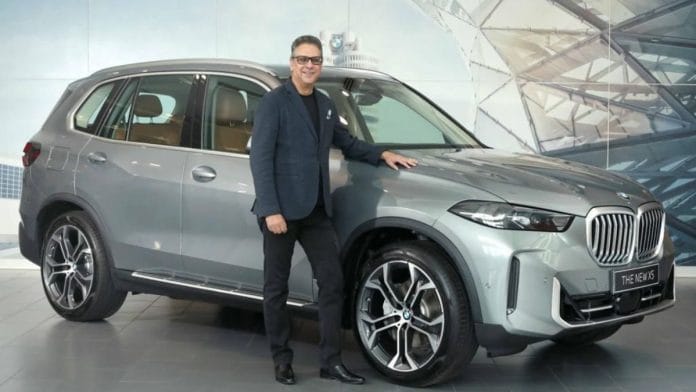A brand-new, gleaming white BMW X5 stands outside the BMW Group Training Centre at Gurugram’s Southern Peripheral Road. Inside, Vikram Pawah, president of BMW India, is pleased as punch to be launching the latest iteration of this SUV, popular among those in showbiz and politics alike. As he talks about the new vehicle, he rattles off a list of features and makes the X5 seem like something from the distant future. Despite the car’s near-crore price tag, he fully expects it to propel the German automobile manufacturer to greater heights in India.
You see, despite the prices of luxury cars from Audi, BMW, and Mercedes-Benz climbing inexorably over the past years, all three manufacturers have posted massive growth numbers between January and June 2023, showing an explosion in demand for luxury cars in India over the same six-month period last year. Mercedes-Benz led the pack with 8,258 units, a growth of 13 per cent. BMW India, which also sells the Mini, sold 5,867 cars, growing 5 per cent. And Audi India, whose sales dropped sharply when it stopped selling diesel cars in India in April 2020, sold 3,734 cars this time, growing by 97 per cent.
India is hungry for luxury cars
For BMW and Mercedes-Benz, sales in the first half of the year are their best-ever numbers in India. And both carmakers could have easily exceeded those figures if they had the products they have now and supply chain issues hadn’t hit hard at the start of the year. “The first four months were difficult”, Pawah tells me. “We had supply constraints, and the new X1 SUV was yet to start sales. Now that supply issues have eased up and we have the full line-up, we have had the best month in our history, which was June. I expect the second half to be even better.”
It seemed to be almost exactly what Santosh Iyer, Managing Director, Mercedes-Benz India, told me when I met him at the launch of the SL55 AMG in Mumbai a few weeks ago. “Supply chain issues have considerably eased up for our popular models such as the C and E Class sedan, but we achieved these higher sales without having the GLC SUV, which is one of our best-selling models in the line-up. Once we launch that car, I expect second-half sales to be even more impressive.”
Sales are growing so impressively that headquarters in Germany are taking notice. Thus, allotments to the Indian market are improving. However, one must remember that Indian luxury car sales are but a fraction of those in China. If the three German companies continue on their current trajectory – along with Tata-owned Jaguar Land Rover (JLR), Volvo, and various imports from other exotic brands – combined sales for this year could touch 50,000 units. No small shakes, and almost doubling the market from 2019-20. But 50,000 units is less than what each one of the German luxury carmakers sells, on average, every month in China. The country’s luxury car sales are estimated to be over four million units annually. The total Indian passenger car market is expected to cross four million this year.
“Luxury cars still contribute 1 per cent of overall passenger car market sales in India,” says Pawah. “Forget China, where that is over 10 per cent. But we have some ways to go to catch up with Malaysia and Thailand, where they are almost 5 per cent,” he adds before becoming extremely optimistic. “There has been a smart economic recovery in India, and the build-out of new high-speed expressways such as the Delhi-Mumbai Expressway will only increase the urge of people to buy our cars.”
Also read: Maruti Suzuki hasn’t cracked the high-end market yet. Invicto can change that
Tapping into the YOLO wave
There has also been a ‘YOLO’ (You Only Live Once) effect after Covid-19, and carmakers are positive that it drives sales. “Buyers began to question why they were saving up money because I think Covid put a sense of fear and mortality into some people, and they wanted to live the moment, now. They didn’t want to wait for a better, new car; they wanted one now,” says Balbir Dhillon, head of Audi India. While YOLO spurred recovery, only sustained economic growth will keep the brands growing, he adds. And one indicator of that, according to him, is the uptick in demand for used luxury cars from Audi’s own network.
And it isn’t as if the growth comes from their entry-level cars; no car from these brands has an on-road price below Rs 50 lakh. All the carmakers have seen their ‘top-end’ or ‘premium’ portfolio, whatever their term is, grow substantially. Sales almost doubled in some cases. And we are talking about vehicles that cost over Rs 2 crore, with those at the very extreme-end costing Rs 8 crore. For BMW India, for example, these cars contributed over 20 per cent of its sales in the first half of the year.
And such bullishness will also mean more assembly work and, eventually, more production in India. Mercedes’ Iyer says that was a major reason for the company to start producing the EQS electric vehicle in Maharashtra’s Chakan. BMW’s Pawah also reiterates that 95 per cent of what the company sells in India is produced outside Chennai.
Back in January, the luxury car market seemed to have recovered from the pandemic, but even in their wildest dreams, automobile manufacturers couldn’t have foreseen this year’s robust demand. The government is very keen that these cars not just be assembled in India but also be manufactured here. And thanks to these sales figures, baby steps are being taken on that front with certain parts such as interior fittings and tires being made in India now for better-selling models. For the industry, the only way is up, but as numbers show, they have just about reached base camp.
@kushanmitra is an automotive journalist based in New Delhi. Views are personal.
(Edited by Zoya Bhatti)






